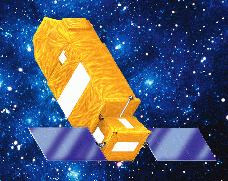

Mission Status Report #23 Star Date: November 5, 1999 NOTE: Mission Status Reports on the web page will continue roughly once a week. 

A graphic view of the FUSE on orbit (left) and the Satellite Control Center at JHU (right). (Click either image to see larger version.)
FUSE Ops Nominal Since Last ReportFUSE Operations have really been very stable since the last report. The UPRM ground station has been working well, with only an occasional minor glitch that is fixed with a remote "reboot" of the control computer. In the mean time, troubleshooting to understand the previous problems we have had with this system, with the help of NASA/Wallops personnel, is proceeding. Target acquisitions have been working very well. New procedures instituted a week ago seem to be working well; an automatic procedure is now in place that can sense when an acquisition "almost worked" but is about to fail, and simply does a "retry." In several instances, review of the telemetry shows that the acquisition then succeeds and things proceed as planned. This means we can schedule acquisitions to happen whenever we want (instead of planning them during ground contacts), which gives us much more flexibility in scheduling. We have continued to intermingle science and checkout observations throughout this time period. For instance, over the last week, we have observed several stars in the Large Magellanic Cloud, a planetary nebula central star, and a Seyfert galaxy. White dwarf stars have also been observed for calibration purposes. However, the lion's share of time has been devoted to some aggressive observing programs that will help us characterize the channel alignment and stability, as mentioned in the last report. For instance, in one test last week, we were able to demonstrate that we can align all four mirrors to good tolerance, move to another position on the sky, and return back to the initial attitude, and the mirrors come back into nearly the same alignment, more than sufficient to observe targets with all four channels of the instrument. Other tests are characterizing how the channels move with various other parameters such as temperatures and look angles on the sky. A team of outside engineers and support personnel are working with FUSE engineers to understand these data and determine the best ways to proceed to keeping the four channels aligned. Good progress is being made. The only down side of all this is that it takes time! It takes time and effort to design the tests and plan and execute them. And it takes time to analyze the data and then interpret what the tests are telling us. Then sometimes what we learn impacts the following tests in significant ways. In the mean time, the science data we are getting continues to provide new and interesting "surprises" to the science team, even while we wait for full science operations to begin. Looking ahead, we have a period in mid-November where normal operations will be put on hold for a few days due to the upcoming Leonid meteor shower. (Click here for more info.) Interestingly, one of the big concerns is NOT from direct damage from a micrometeroid itself, but from possible electrical surges that might be produced from such an impact. FUSE will point in a benign direction during the storm and turn off many of it's high voltage electrical systems as a precaution. Reported by: Bill Blair, Chief of Mission Planning
|